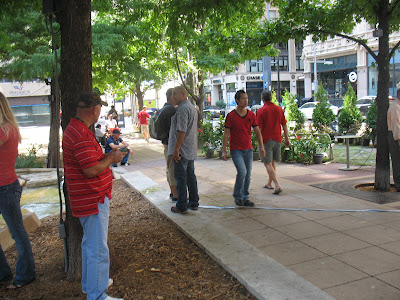Here was a cool little bonus. Unrelated to Park(ing) Day was a Green Expo at Main Street Gardens. It added a nice little bookend to Main Street.
Live music was a common theme for many of the parklets.
This is a shot down Main Street. I added this one to show the congestion on Main Street. This runs contrary to most public policy stances. The general idea is that places that are congested lose their desirability (think of the Yogi Berra saying, the place is so crowded, no one every goes there anymore). Yet, the reality shows the opposite. Yes, this is a one-time event, but it applies to permanent places.
Outside Pegasus Plaza. There is a lot of pedestrian activity here.
This was a live music-type parklet, but anyone on the street could join and do what they wanted. I liked this one a lot because it was representative of what a great urban areas should be.
This parklet was put together by the leasing office of the residential building I reside. They made a small croquet field.
I included this one, not because of any great idea or activity, but the poor urban design of the area. Notice how the others, taken up and down Main Street, are nice and shaded with pedestrian amenities. Going from east-to-west, when you cross Field St, you get to the One Main Place area. It is nice and concrete-ty, complete with a big setback, no shade and barren streetscape. I felt bad for the guys who got this space. Since it is hostile to pedestrians, none are here. Yet, all along Main, people were gathered in droves in the 90 degree heat. If you design it right, people will use it.
On Friday, Main Street was quite busy, but what about now? And what lasting effects will come of it? That is a little bit harder to answer. I was talking with the organizer of it a few days before and that was the question that came up. The more I got to thinking about it, the more I realized something.
Dallas is great at doing the temporary. The better block project that has been done in Oak Cliff, Deep Ellum and Ross, demonstration bike lanes and Park(ing) Day. But in the end, not much changes. Some things in Oak Cliff have, but that's because they are taking things in their own hands, not because of any systemic changes at City Hall.
In the end, I think these things serve one major lasting purpose. It does show that the younger generation is pushing for change in how our cities are built and operate. In the end, that may be the best thing of all.






